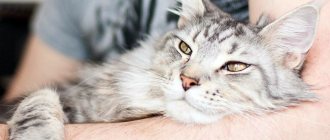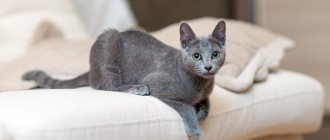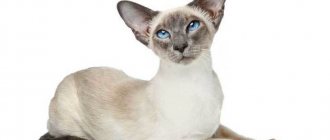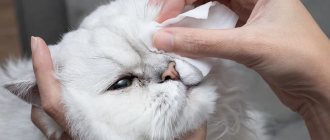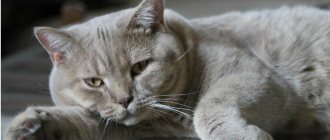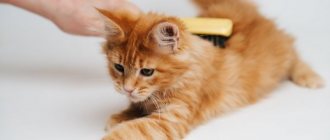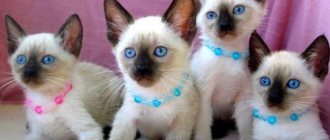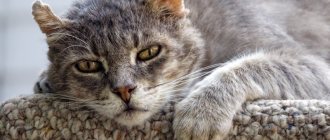Features of behavior and character of British women
When characterizing British cats, you need to understand that everything depends on their behavior. If you want to raise an animal, then you need to do this only up to a year, after which you won’t be able to change anything. Some owners complain about disobedience, not realizing that this is a consequence of poor upbringing . The British are proud enough that they will never ask a person for help. These are not the breeds that will cuddle or purr plaintively, trying to attract attention. These representatives will try to act independently.
While still babies, British kittens easily learn to use the litter box. The aristocratic breed does not allow them to shit wherever they have to. If you look at how a cat sleeps, you can involuntarily smile: on its back, in a ball, with its hind legs outstretched, on its side. The places to sleep are no less fun. Sometimes fluffy hides in places where you wouldn’t even think of looking for him - in a laundry basket or among soft toys. The habits of the British dog are often unpredictable, but this is dictated by the breed and some inherent instincts.
Character of British cats
Multifaceted and contradictory - this is how the character of “aristocratic animals” can be briefly described. Representatives of the British differ significantly in disposition from other cat breeds.
- They won’t sit in the kitchen and yell for food to be poured into them.
- They will not ask to be held by their owner, and will not sit on their laps if you take them by force.
- They won’t rub against their owner for days.
Cats spend all their free time to their advantage and do what they want. The British are independent and proud.
Cleanliness
Cleanliness is something that cannot be taken away from British women . This is inherent in them, this is what their mother cat teaches them. Purrs can lick themselves for hours without getting tired, and until the procedure is completely completed, they will not switch to another activity.
Representatives of this breed will not allow themselves to tear up furniture if they have a nail clipper for this purpose. Having shown the animal a couple of times the place reserved for sharpening nails, they will remember it forever.
The British are not short on intelligence. Tangles understand everything almost the first time. The only task that lies with the owner is to initially show the animal where to go to the toilet, where is the place to eat, where is the lounger, and the like.
Amenability
The British Shorthair cat gets along well with any animal, be it dogs, cats, parrots, iguanas and other representatives of the “wild world”. If a Briton doesn’t like something, he will not tolerate the disgrace that is happening next to him, but will turn around and proudly leave.
The same applies to children: when kids don’t touch cats, they don’t pay attention to them. Otherwise, the felines get up and go home.
Stubbornness and touchiness
All cats are stubborn in their own way, and the same applies to the British. Speaking about the character of British cats, it would not be out of place to say that they do everything according to their own wishes and at their own discretion. If a furry friend doesn’t want to lick him out of his house to play in the cold season, for example, then you can’t force him to do it. Of course, you can shake the animal out by force, but it will immediately find a place where no one will disturb it.
As for touchiness, pets have plenty of this. If the owner scolded the four-legged animal undeservedly or suddenly raised his hand to it, one should expect trouble. The cat will not forgive this, so it will sit in the shelter for a long time, and then refuse to eat.
Important! To avoid having to scold an adult cat for the slightest misdeeds, kittens should be taught order from childhood, instilling in them certain skills.
Restraint
The character of British cats is such that they do not like to show tenderness, love or resentment towards people, and especially in front of strangers. When an animal is offended, it will lick itself for a long time, thus relieving stress. A joyful bundle can make a circle of honor around a person, and then climb into its house or go to another favorite place. Only some representatives of the British can be gentle and loving, but this is due to the merit of the person who taught the animal to do this from childhood.
Playfulness
A cat's life consists of more than just sleep and food. Games play a big role for felines. The British are big fans of fooling around, of course, within the limits of what is permitted. An exception may be adult cats, although they can sometimes be caught doing this.
Kittens are overly selective in their games. What they like most is hiding and emerging from their ambush. Attacking is another fun activity for them. In this way, they try to imitate adult representatives who, in a playful way, teach their children to attack and also defend themselves. Sometimes, when kittens are tired, they pretend to sleep so that they can be left for a while. And after a short period of time, they pick up, raising their tail, and begin to chase their prey again.
Animals associate some toys with real prey - mice or rats. Swinging objects may remind four-legged birds of birds or butterflies that they so want to catch. At the same time, animals understand perfectly well that when playing, they are not hunting anyone, so they behave somewhat differently. When tracking real prey, the pets are serious and attentive, sometimes the cats are angry, but you can’t do without this when hunting. At home, they rarely release their claws, and their bites do not hurt at all.
Knowing the character of the British, many breeders recommend that owners set up a small corner for their pets, throwing small toys and strings there. If a person does not have time to play with his four-legged pet, then he needs to be given the opportunity to occupy himself independently.
Important! Cats who are not given time and who do not have toys begin to play mischief: jumping on furniture, hanging on curtains, knocking down everything in their path. And this is not the fault of the animals, but of the people who did not provide their pets with everything they needed.
Reviews from owners of mixed-breed cats
People pay a lot of money for purebreds in order to brag about it to their relatives or friends. Or people buy expensive animals with the prospect of making money on it, for the purpose of further breeding and resale. As for intelligence and ingenuity, it’s possible! After all, breeders develop cat breeds not only based on the external qualities of the breed, but also on the internal ones: crazy. stability, aggressiveness, ability to train, etc. It is difficult to judge, because in the same litter of even the most thoroughbred there can be different specimens with different psychos. qualities. The same can be said about mestizos. My opinion is that all cats are almost equally smart and smart. Everything will depend on the conditions of their detention and, of course, the actions of the owner (training).
Bino [9.1K]
https://www. bolshoyvopros. ru/questions/134644-porodistye-koshki-umnee-metisov. html
Scavenger cats living on the street are superior to domestic cats in cunning and reaction speed, and even in intelligence and physical fitness by a head. Only a smart, thieving petty predator is an unpleasant roommate. And purebred cats - the dumber the better. Then there is less hassle with them. In fact, the British proved that the intelligence of cats is at the level of domestic cattle, namely the low-intellectual “ship of the desert” camel, which even sheep are superior in intelligence to. But mestizos are not predictable in terms of intelligence, and much depends on living conditions.
Anachoret [110K]
https://www. bolshoyvopros. ru/questions/134644-porodistye-koshki-umnee-metisov. html
I also have a cat, a domus, a castrato. Most likely a crossbreed between someone and someone, but I can’t say for sure who exactly. It is clear from him that he is one of the “noble”, His character was found by my son under the loggia (we have the first floor), he is so small, he fit on the palm of his hand... But now... Huge, calm, affectionate, but he himself will never come to his stroked. He's like our nanny. Kids love to play with him, run after him, ride on him, bite and scratch him... he endures everything like a true, loving, kind guy. Red never offended a single bully kid. And he won’t eat until everyone has eaten.
Moray74
https://teron. ru/index. php? showtopic=928228
I believe that outbred animals are at least in better health than their purebred counterparts. As for intelligence, here too my observations are in favor of mestizos (although maybe it’s just me who was so lucky with smart cats). I communicate with girls who place animals in good hands, and among the “abandoned” cats, even those who were born on the street and never knew what a litter box was, within a week they immediately figured out where they could relieve themselves and where they could not, and owners of thoroughbred dogs bought for money often complained about “toilet surprises” of their pets, although innate cleanliness and the desire to take revenge on the owner for something may play a role here (in this regard, street dogs are less vindictive and are accustomed to “covering their tracks,” while thoroughbred dogs are often more spoiled or something). And they take animals from nurseries and for a lot of money for various reasons: fashion, the desire to make money from breeding, simple ignorance of where you can find a cute pet for free, a subjective opinion formed for one reason or another.
Oksi-84 [33.6K]
https://www. bolshoyvopros. ru/questions/134644-porodistye-koshki-umnee-metisov. html
Purchasing a mixed breed is a lottery. When choosing a pet, first of all, listen to yourself. If the heart tells you: “That’s it. This is mine!”, then a completely outbred kitten will bring you more joy than a three-time certified champion. He will become a true friend for you. Will give tenderness, warmth and affection.
Psychology of British cats
The character and behavior of a British cat can be very different. However, the key determining factor is the animal's mood. The owner himself can spoil it or, on the contrary, improve it. Despite the fact that the pet is self-sufficient and can be alone for a long time, it cannot be ignored.
Some owners of four-legged animals complain that with the appearance of a child or another animal in the family, the British change, become closed and touchy. This happens because no one pays attention to the furry friend; they found a replacement for him. The British actually become very attached to their owners, but only because of their disposition do they not show it. However, this does not mean that animals can live on their own; they also want to be handled and noticed.
Habits
The bright character traits of the British directly influence their habits. Some people believe that since animals belonging to the presented breed are quite obedient, then they cannot do any bad things, but this is not so.
Common negative habits include:
- Scratching and biting hands.
- Throwing objects off surfaces.
To somehow compensate for this, many people want to know how the British are doing with catching mice, and this is a completely different matter.
About activity
The character of British kittens, like cats, can actually be reserved and sometimes even cold, but this does not in any way affect their activity. The British sleep a lot, but in their free time they will do what they want: run, jump, play. The exception in this case is only older representatives of the breed. Pets that have access to the street are more active. They are interested in everything around them: leaves, butterflies, flowers, so cats can spend hours on end outside. If there are several cats in the family, then additional activity will be provided. This is very good, since active animals have much fewer health problems.
Important! To prevent your cat from lying around in the apartment, you should play with him from time to time and offer him some options for useful ways to spend his waking hours.
Characteristics of British kittens
Breeders select healthy individuals without genetic or other abnormalities, with a stable psyche and a friendly attitude towards people.
By purchasing an animal without documents, you risk purchasing a pet with diseases of various origins, weak immunity, or encountering unpredictable behavior. Because a breed is not only a name and appearance, but also a character.
British cats need constant attention, which is important for people who are outside the house all day. With a self-sufficient and independent character, British cats are not aggressive in critical situations and are not prone to attacking people.
From birth, the British are clean and almost immediately get used to the tray and scratching post.
As for the appearance of the British, they are easily recognizable among others. British cats are classic representatives of the semi-cobby type. This body type includes the following characteristics:
- strong and short wide-boned body;
- short rounded paws:
- powerful short neck;
- a large round head with cheeks that resemble jowls;
- erect ears with soft rounded tips;
- Their nose (British cats), wide from the bridge of the nose to the tip, has a depression;
- large round eyes;
- short tail with thickening at the base and rounding at the end.
Thus, the British is a collection of soft, rounded shapes. All physical parameters are strictly regulated, so deviations from them are considered a violation of the standards and result in the cat being rejected.
But in addition to their special memorable appearance, these cats have good hereditary characteristics. With proper care, they have virtually no health problems, and their life expectancy ranges from 12 to 20 years.
It is widely believed that a British cat can be distinguished from its relatives of another species by its eye color. This is not an exact sign, since a kitten’s eye color can only be fully determined by the first year of life.
In addition, eye color is tied to coat color and this must be taken into account when choosing a pet, as well as the fact that the presence or absence of certain traits is genetic.
Genes are divided into dominant and recessive, which means that no matter how beautiful blue eyes look, they are rare among British cats. After all, the gene for blue eyes is recessive, that is, it is suppressed by others.
Do the British have bad habits?
It is believed that aristocrats do not and cannot have bad habits. Of course, the behavior of British cats may sometimes not fit into the generally accepted framework of these peculiar animals, but in any case, representatives of other breeds should be compared to them. This is not entirely true.
There are several bad habits of British cats that you should be aware of:
- Using the owner's personal belongings as toys, as well as items that cannot be used for these purposes. We can talk about jewelry, tubes of creams, sweets. If there is no fear that the animal will take these items somewhere, then you should not take them from him. The kitten will frolic a little and will lose all interest in what was just found. Otherwise, it is better to pick up the item, but be sure to exchange it for any other one.
- Some animals love to climb inside bags, boxes, packages and cabinets. It is difficult to find an explanation for this, but this does not mean that the pet will immediately stop doing this. In this case, you can also do it in two ways - allow it to be done or try to wean it off by replacing one activity with another.
Britons may actually be skittish animals, but they are also very intelligent, playful and active pets.
Source
Mixed cat, what does it mean?
Metis is not a cat breed. Such animals appear in a parent couple, where one is a representative of an elite breed, and the second is outbred. Another option is possible - when both parents are elite, but belong to different breeds. Crossing between them is allowed, and the litter acquires the qualities of the parent pair and is able to continue the race.
There is another concept - a cat hybrid. This means that individuals from different branches of the biological tree participated in the crossing. For example, a caracal from the Moscow Zoo mated with an ordinary cat, which subsequently gave birth to a healthy large kitten.
This event became a sensation in world felinology and forced a new look at the process of breeding hybrid cats. Thus, the Chausie breed appeared - a hybrid of the wild jungle cat Felis Chaus and the Abyssinian cat, and the Savannah - a mestizo cat bred by mating an African serval and a bengal.
Diseases of Orientals
Orientals for the most part are fairly healthy animals, without genetic diseases, with a fairly strong immune system. This is probably due to the fact that the Oriental cat is quite young, and its genetics includes representatives of different breeds.
But there are still several diseases that spoil the overall health picture of Orientals. This:
- heart failure (cardiomyopathy);
- flat chest (breathing becomes difficult, the diaphragm is disrupted and the heart is compressed);
- retinal atrophy;
- liver amyloidosis (protein metabolism disorder);
- gingivitis.
Oriki are also susceptible to colds and other diseases associated with hypothermia (for example, otitis media).
With proper care and quality nutrition, your Oriental cat can live 15–18 years.
Advantages and disadvantages of mestizo
According to official data, there are 250 registered cat breeds. The total number of cats living throughout the globe is about half a billion. In addition to officially recognized breeds, there are also stray animals that are not included in the statistics. Random mating results in a huge population of mestizos. Whether this is good or bad is difficult to say, but we have identified several advantages and disadvantages of being mestizos.
- In the first generation, mixed-breed kittens receive the best characteristics of the parent pair, but later, unfortunately, they lose them.
- Mixed breeds are often healthy, but if one or both parents have an altered genotype, the kittens are more likely to be born sick.
- By purposefully crossing several breeds, it is possible to obtain an animal with a certain set of external qualities.
- The character also determines the genotype of the parental pair. A pampered Persian cat and a calm mongrel cat will not produce aggressive kittens.
As for the disadvantages, there are few of them - keeping a mestizo in the house is neither prestigious nor profitable.
Half-breeds do not have the right to participate in exhibitions, do not have a pedigree, are not allowed to crossbreed with elite animals, and there is no queue of people who want to get a purebred pet. However, cat lovers in most cases do not pay attention to such nuances and happily take outbred animals from the shelter.
Tips for choosing a mixed-breed kitten
Since in the category of mestizos there are no clear requirements for breed qualities, when choosing a pet you should pay attention to other characteristics:
- In a mixture of a British Shorthair and a regular cat, it is worth studying the animal's coat - the variety of colors sometimes leads to very unusual combinations and shapes. Each kitten will eventually find its owner, but not every owner wants to get a pet with an unusual color. For example, there are people who categorically do not accept black cats of any breed, while others intuitively avoid tortoiseshell coloring.
- A mixed Siamese and British cat kitten may be born with thin “Siamese” paws. If a pet inherits a powerful body from a Briton, then it will be difficult for him to maintain a lot of weight. This may manifest itself as stiffness of movement during games. In the future, this symptom may disappear or develop into a serious problem with the musculoskeletal system.
- An objective indicator of an animal’s good condition is its fur. If it bulges, does not lie flat, clumps into small icicles and does not shine, it means the kitten has health problems.
This is interesting! Mixed breeds have a low threshold for reblooming. The color tone, which is established by 3-4 months, as a rule, does not change later.
Although the behavior of cats is not regulated at the genetic level, the character traits that are passed on from each parent always influence the pet’s habits.
- A mixed breed of British and Siamese should not be adopted in families with small children. There is a high probability that a child’s annoying caresses will provoke aggression. If the British half of the cat’s nature considers it necessary to leave in such a situation, then the Asian blood immediately offers to attack and prove its own superiority over the enemy.
- A cross between a British cat and a purebred cat is a good choice for active people who prefer close contact with their pet. Such a mixed breed will be sociable, willingly support the company and play with pleasure with the owner.
In order not to make a mistake in choosing a mixed-breed kitten, you need to focus on the parent breeds, since the temperament of an adult cat necessarily combines their features. And the proportion in which they will develop will depend on the cat’s upbringing and the conditions of its keeping.
Caring for mixed-breed cats is not very difficult. If we are talking about the offspring of two short-haired breeds, then hair care can be limited to weekly combing of the pet.
Metis, like other cats, do not like water. But if you accustom your animal to water procedures from childhood, the cat will feel quite comfortable while bathing. If a mestizo has long and fluffy fur, the owner will have to carefully care for it to prevent the formation of tangles.
Maine Coon mixes
The Maine Coon is a large-sized native cat breed. The animals are distinguished by their massive build, strong bones, angular contoured muzzle, and large ears with tufts. Colors can be any: cinnamon, lilac, chocolate and fawn, solid.
The coat is thick, water-repellent, and the undercoat is soft. The neck is decorated with a frill. The tail is long, wide at the base, tapering to the tip, covered with long hair. The eyes are oval, expressive, the color of the iris matches the color of the coat.
Breeding Maine Coon mestizos is officially prohibited, but in reality this issue is not controlled. Amateur breeders often breed Maine Coons with other cat breeds. Half-breeds are much cheaper, which increases the demand for them.
In specialized nurseries, cull cats are not sold for breeding, but they can be purchased as a pet. Such animals must be castrated or sterilized.
It is also important to remember that a purebred Maine Coon and a mixed breed are completely different animals. A half-breed will never meet the breed standard. The appearance of such cats is very diverse and depends on the genotype of the parents.
Purebred Maine Coons are endowed with the following qualities:
- goodwill;
- agreeableness;
- sociability;
- devotion;
- prudence.
When crossed with a regular cat, these traits change or disappear completely.
As for external qualities, purebreds must have tufted ears, an elongated muzzle, massive paws, and a long fluffy tail. Three-month-old kittens should weigh at least 2.5 kg (the cubs of an ordinary cat at this age weigh no more than 1 kg). The body length of adult males is approximately 1 m and weight is 11 kg.
As for attempts to crossbreed the Maine Coon with other breeds, they all failed. The purpose of such experiments was the desire to add some qualities from other breeds to Maine Coons. For example, to produce a big cat of an unusual color, a female Maine Coon was bred with a male Siamese breed. However, the experiment was unsuccessful - kittens of different sizes were born in the litter.
When mated with Persians, the result was large kittens with fluffy red fur without the slightest hint of resemblance to Maine Coons. An attempt to crossbreed with a Bengal to increase body size also failed.
Maine Coon and Siberian kittens are similar in appearance to purebreds, but are of medium size. Such babies are often passed off as noble, but they are sold at a discount and without a pedigree.
A mixed breed of a Maine Coon and a domestic cat was obtained completely by accident. The baby retained the color of his coat, but lost a number of positive character traits.
Maine Coons are also crossed with Britons, Neva Masquerade and other breeds of cats, producing litters with fur of different lengths.
Metis with British
The British cat is an indigenous breed with an ancient history of development, which begins in the days of the Roman legionnaires. These animals are endowed with refined manners, prefer solitude, do not like noisy companies and too active games. The most common crosses of British cats are with ordinary cats, with Toygers and with Siamese.
A mix of a British cat and a regular cat
Outbred cats have an amazing ability to quickly adapt to their environment. These animals are independent, unpretentious, endowed with excellent hunting skills that allow them not to die of hunger, which cannot be said about most purebred domestic cats.
It is worth noting that street cats do not strive for privacy; they are sociable and do not mind contact with people if they behave kindly. Animals that are brought into the home at an early age are socialized no worse than purebred cats.
Mixed breeds of a British cat and a regular one are most common. Sometimes at first glance it is even difficult to distinguish who is who. Half-breeds have the same massive bone structure and broad chest, but are slightly smaller in size. Developed cheeks make the muzzle round.
Coat colors are varied. The British are characterized by about 200 colors, so the color options for mixed breeds are unlimited. There are individuals with a color-point mask like the Siamese or spectacular silver chinchilla ticking.
The Métis partly adopt the British desire for privacy. Such animals are more eager to be the center of attention; they are quite sociable and responsive.
Interesting. At an early age, half-breeds exhibit to a greater extent the manners of mongrel animals, and in adulthood they show prudence and sedateness - qualities inherent in the British breed.
Toyger/British mix
Mixed Toyger + British cat is an animal with a clear striped pattern on its fur. The Toyger breed was developed relatively recently and received admission to the exhibition career in 2007. These cats are characterized by the only so-called brindle color.
Toygers are much thinner than the British, have an elongated body and long legs. Mestizos are distinguished by an average constitution, proportional physique, and a beautiful fur coat with a tabba pattern. The bands may be clear or blurred, but are present in 95% of cases.
The character of half-breeds is more reminiscent of the British. They are just as prim and calm. Second-generation mestizos resemble only one of their parents.
Mix of Siamese and British cat
Mixed breeds of British and Siamese cats are spectacular beauties with a solid color, for which the C gene is responsible, which is involved in the formation of the color point color.
The Siamese color depends on the animal's body temperature. The body of cats is warmer, so the gene does not appear in this part of the body. The fur on the body is always light. The limbs, ears, muzzle and tail are cooler, so the coat is darker in these areas. The British are also characterized by the Siamese color, which is inherited.
A cross between a Siamese and a Briton looks heavy, has a massive bone structure and a wide chest, long legs and a tail.
Kittens inherit an independent character and egocentrism (from the British), resentment and rancor (from the Siamese). The British genotype is considered dominant, which is often expressed in complete resemblance to the aristocratic breed.
Mixed bengal cat
The Bengal cat is a cross between a domestic cat and an Asian leopard. Mating Bengals with other breeds is prohibited by all felinological organizations. There are no recognized crossbreeds of this breed, but this does not prevent unscrupulous breeders from crossing Bengals with other breeds or ordinary cats. As a result, mestizos with a variety of colors appear. The second generation completely loses the characteristics of its parents.
Recently, long-haired Bengals have become especially popular; they retain the characteristics of the breed, but have long hair, a fluffy collar and tail.
If earlier breeders sterilized such animals, now the long-haired variety is valued higher than the traditional Bengal cat.
At what age will the difference be clearly visible?
The characteristic appearance of the British breed distinguishes them from representatives of other breeds even at a very young age. However, only an adult, mature individual can be checked for compliance with the standards. Then we can say whether it is a purebred cat or a crossbreed.
Depending on the breed, the age at which a cat is considered an adult also varies. Bengal cats take 9 months to fully mature, Maine Coons take 2 years.
The British breed is considered mature at 12 months of age. Around this time, all processes associated with changes in coat and eye color are completed.
Persian cat mixes
The Persian cat is one of the most popular breeds in the world. The variability of colors is amazing; in this regard, Persians have no equal. In this regard, the number of Persian cat mestizos is growing steadily. The most widespread is the cross between the Persian and the British. Mixes of an ordinary cat and a Persian are often found. Of particular value are the Scottish Fold and Persian half-breeds.
Persian cats are often used to develop new breeds. One of these is an exotic cat. Externally, the exotic resembles a Persian, but has short hair.
Other famous breeds derived from the Persian cat:
- Napoleon - a mixture of a Persian and a Munchkin;
- Himalayan - a cross between a Persian and a Siamese;
- Cherub - a curly-haired Selkirk Rex with the face of a Persian cat;
- Tiffany - a mix with a Burmese, with an unusually soft and silky coat;
- The Alaskan Snow Cat is a cross between a Somali and a White Persian.
Reference. Interspecific crossing does not affect the health of mixed-breed Persians and other cats, except for the risk of genetic diseases.
Metis or mongrel?
True purebred cats are significantly inferior in number to outbred and mestizo cats, the difference between which lies not only in color, but also in behavior and health. As a result of family ties that were carried out for improvement, purebred cats have numerous mutations and a number of congenital pathologies. Mestizos and outbreds are distinguished by stronger physical characteristics and immunity.
Outbred cats often have short hair, which helps with hygiene. The most common color is brindle, but tortoiseshell, blue, spotted and solid are also found. According to their external characteristics, yard cats can be divided into northern and southern types. Those living in the north are distinguished by thicker, lighter hair and stocky, large physiques, while those living in the south are darker, smoother and more graceful.
A mixed-breed cat is also a mongrel cat, but has the characteristic features of purebred cats. This is manifested in color and physique, character and health. Mixed breeds have a chance to get the breed. To do this, the owners need to breed offspring from a mixed-breed parent couple (not father and mother, but of the same breeds) and cross the offspring with each other. And only the fifth generation can become a contender for thoroughbred.
We choose by appearance and character
Every cat is unique. However, experts say that a pet’s character and susceptibility to diseases can be predicted by its external features. Mixed breeds of elite cats inherit the exterior and temperament that are characteristic of a particular breed. When choosing a mestizo, pay attention to the phenotype.
"Marquise" phenotype
Such animals are characterized by the following features: short black hair with white spots, a dense body constitution in males, and graceful in females. The phenotype is most often found in short-haired European breeds. Such animals have a stable and quite predictable character. Cats clearly demonstrate their intentions and achieve what they want with perseverance and affection.
Nutritional Features
The diet of mestizos is no different from the diet of purebred cats. Considering that felines are obligate animals, the main ingredient in their menu should be meat. In second place are animal fats, in third place are carbohydrates in minimal quantities.
Cats can be fed natural foods:
- rabbit or lamb meat;
- chicken;
- turkey;
- veal;
- chicken giblets;
- sea fish;
- greens;
- fresh vegetables;
- eggs;
- fermented milk products.
You should not give salted, fried, spicy, sweet foods, whole milk, river bony fish, tubular bones. Forbidden delicacies cause excess weight gain, metabolic disorders, and failure of the endocrine, cardiovascular, and urinary systems. Buy treats at veterinary pharmacies or pet stores.
Meals are selected individually. Energy value and nutrient requirements depend on:
- physiological state of the cat (pregnancy, castrated and sterilized animals);
- body weight, constitution;
- health conditions;
- age;
- conditions of detention;
- activity level.
If your choice falls towards dry food, buy premium and super-premium products, as well as dried and canned food labeled holistic. Holistic food contains natural meat and fish, vegetables, berries, fruits and herbs. They do not contain artificial additives to improve taste and smell, unlike economy class feeds.
Caring for Mestizos
Recommendations for caring for half-breeds are the same as for purebred cats:
- Long-haired animals need to be combed daily, especially carefully during seasonal shedding. Short-haired cats are combed 2-3 times a week using a furminator, comb, or stiff brush. Persians should not be scratched with a slicker brush, which will damage the delicate hairs.
- Shampoos and conditioners for long-haired cats are used for bathing. Considering the dislike of cats for bathing, with the exception of Maine Coons, this should be done in case of emergency. Cats are clean creatures and are able to keep their coats clean on their own.
- The eyes and ears are examined once a week and cleaned with special lotions or clean water. Persians, like mixed breeds, collect discharge in the inner corners of their eyes that must be removed daily to prevent the risk of developing a bacterial infection.
- Animals should have special rodents freely available to remove plaque.
- A nail clipper is used to trim claws. The procedure is performed carefully, trying not to touch the blood vessels.
It is important to keep the tray clean. The filler can be anything: wood, clay, clumping, silica gel. Some cats eat silica gel granules for some unknown reason. If you notice that your pet is partial to this filler, change it to another one. It is advisable to change the wood one every two days or daily.
Diseases, their prevention and treatment
Mixed-breed cats are generally healthy animals; their susceptibility to diseases depends on their phenotype:
- The “marquise” phenotype has excellent health, but if there is a malnutrition, urolithiasis develops.
- Representatives of the “Siberian cat” phenotype often experience digestive difficulties and are prone to rapid weight gain, diabetes and urolithiasis.
- Angoras have good health, but some individuals have breathing problems.
- In the “Persian” phenotype, diseases of the upper respiratory tract and genitourinary system are observed.
- Representatives of the “oriental” phenotype rarely get sick, but sometimes they are diagnosed with gastrointestinal diseases.
- “Thais” have good health, but some individuals are predisposed to urolithiasis and infectious diseases.
- “The British” are prone to chronic kidney disease, obesity, and suffer from endocrine system disruption and chronic pancreatitis.
Treatment is prescribed exclusively by a veterinarian after a series of diagnostic and laboratory tests.
Prevention of infectious diseases involves timely vaccination, which must be carried out even if your pet does not go for walks in the yard. We bring viruses and bacteria home on the soles of our shoes; mating with animals without a veterinary passport means an increased risk of contracting a genitourinary infection.
According to the vaccination calendar, pets are vaccinated according to age against the following diseases:
- Rabies is an infectious disease that has no cure. Carried by infected animals and rodents.
- Rhinotracheitis is a herpesvirus infection that affects the respiratory system and eyes. Characterized by an acute course. Carriers are sick cats.
- Calcivirosis is an infectious disease transmitted from other cats. Mortality is more than 80%.
- Peritonitis is a disease caused by coronavirus. The route of infection is airborne. Mortality is more than 90%.
- Panleukopenia or feline distemper. – an acute viral disease transmitted from sick cats. Difficult to treat, leads to death in 90% of cases.
- Chlamydia is an infectious disease characterized by a long course, transmitted by birds and rodents, and affects the genitourinary, visual, respiratory, and digestive systems.
- Microsporia or ringworm is a skin disease transmitted from sick animals, as well as from cats to humans.
- Panleukopenia, chlamydia, calcivirosis, rhinotracheitis - at 8 weeks, revaccination at 10-12 weeks, then annually.
- Rabies - at 12 weeks, revaccination every year.
- Microsporia - at 8 weeks, revaccination after 14 days, then annually.
- Viral peritonitis - at 16 weeks, revaccination after 4 weeks, then every year.
What does a typical breed look like?
The Serengeti have a large, lean body and an athletic build. The back line is straight, the chest is deep. The limbs are muscular, very strong, with powerful claws. They hold the record for the length of their paws among domestic cats. The length of the tail is equal to the distance between the croup and the shoulder blades; the tail itself is strong and mobile. Weight averages 12 kg. The weight of cats starts from 8 kg, and the weight of cats can reach 15 kg.
The neck is long, muscular, smooth in outline. The head is medium-sized and has an elongated wedge-shaped shape. The profile of the frontal-nasal part of the skull has a straight line, the cheeks are flat. The ears are wide, set high, close and vertical, with rounded tips. Ideal proportions are considered to be equality between the height of the head and the length of the ears. The eyes are round, medium in size, yellow-copper in color, very expressive thanks to the black eyelids. The nose is equally wide throughout its entire length, and the chin is graceful.
Colors:
- black;
- smoky with a spotted pattern;
- tabby based on black, brown and silver shades;
- aka lynx-point - this option is in development and looks like large dark spots on the ivory-colored coat.
The spotted pattern is located chaotically, round and horizontally elongated spots are acceptable. The coat is short and quite soft, the presence of shine is welcome, as long as it does not reduce the contrast of the pattern.
The Serengeti breed meets the standard of the International Cat Association and is included in the TICA list of experimental breeds, but is not yet approved. The selection is far from complete, while some breeders today are working to improve the breed with an emphasis no longer on the external qualities that Karen Sauzman tried to strengthen. In particular, this concerns the size and shape of the ears. The original idea was to breed cats with large, pointed ears, but now the opposite trend is observed.
